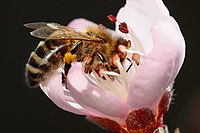
Photo from wikipedia
The Japanese plum (Prunus salicina Lindl.) is a fruit tree globally cultivated in temperate regions of the world. Its floral biology and yield are affected by several factors, with issues… Click to show full abstract
The Japanese plum (Prunus salicina Lindl.) is a fruit tree globally cultivated in temperate regions of the world. Its floral biology and yield are affected by several factors, with issues related to self- and cross- (in) compatibility among varieties being emblematic of the whole Rosaceae family. The aim of this work was to elucidate the fruit set, dynamics of pollen tube growth in pistil, and yield and other fruiting attributes, in ‘Satluj Purple’ and ‘Kala Amritsari’, probably the most popular subtropical Japanese plum varieties in northern regions of India. Specifically, we examined the response of six different pollination variants, namely to self-pollination, open-pollination with the two cultivars located in adjacent rows, open-pollination with the two cultivars located in distant rows, manual cross-pollination, supplementary pollination, and floral bouquet. During the two years of the investigation, both plum cultivars showed good in vitro pollen germination (on average, above 50%) at different sucrose concentrations, with the highest values for the ‘Satluj Purple’ and for the 15% concentration. In vivo, the analysis of the pollen growth in the various sections of the style indicated the best performance when pistils of ‘Satluj Purple’ were pollinated by pollen grains of cv. ‘Kala Amritsari’. Cross-pollination also registered faster growth of pollen tube in pistil with the lowest number of incompatible pollen tubes compared to open- and self-pollination. From the productive point of view, cross-pollination showed the most pronounced results among the different pollination variants, with the highest initial fruit set (36.6%) and yield (28.0 kg/tree), and the shorter fruit development in ‘Satluj Purple’ (fruit set and yield in self-pollinated ‘Satluj Purple’ trees were 3.3% and 2.0 kg/tree, respectively). Conversely, the use of ‘Satluj Purple’ pollen for ‘Kala Amritsari’ showed poor results. Finally, in our study, ‘Kala Amritsari’ showed self-compatibility. We conclude that the main cause of poor fruit set in ‘Satluj Purple’ is self-incompatibility. The relevant genotypic-specific effects revealed by the analysis of the various pollination treatments also highlighted the importance of interplanting to increase fruit set and yield for subtropical Japanese plum varieties.
Journal Title: Plants
Year Published: 2022
Link to full text (if available)
Share on Social Media: Sign Up to like & get
recommendations!